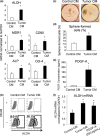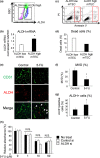Tumor endothelial cells with high aldehyde dehydrogenase activity show drug resistance
- PMID: 28851003
- PMCID: PMC5666026
- DOI: 10.1111/cas.13388
Tumor endothelial cells with high aldehyde dehydrogenase activity show drug resistance
Abstract
Tumor blood vessels play an important role in tumor progression and metastasis. We previously reported that tumor endothelial cells (TEC) exhibit several altered phenotypes compared with normal endothelial cells (NEC). For example, TEC have chromosomal abnormalities and are resistant to several anticancer drugs. Furthermore, TEC contain stem cell-like populations with high aldehyde dehydrogenase (ALDH) activity (ALDHhigh TEC). ALDHhigh TEC have proangiogenic properties compared with ALDHlow TEC. However, the association between ALDHhigh TEC and drug resistance remains unclear. In the present study, we found that ALDH mRNA expression and activity were higher in both human and mouse TEC than in NEC. Human NEC:human microvascular endothelial cells (HMVEC) were treated with tumor-conditioned medium (tumor CM). The ALDHhigh population increased along with upregulation of stem-related genes such as multidrug resistance 1, CD90, ALP, and Oct-4. Tumor CM also induced sphere-forming ability in HMVEC. Platelet-derived growth factor (PDGF)-A in tumor CM was shown to induce ALDH expression in HMVEC. Finally, ALDHhigh TEC were resistant to fluorouracil (5-FU) in vitro and in vivo. ALDHhigh TEC showed a higher grade of aneuploidy compared with that in ALDHlow TEC. These results suggested that tumor-secreting factor increases ALDHhigh TEC populations that are resistant to 5-FU. Therefore, ALDHhigh TEC in tumor blood vessels might be an important target to overcome or prevent drug resistance.
Keywords: Aldehyde dehydrogenase (ALDH); angiogenesis; endothelial cell; resistance; tumor.
© 2017 The Authors. Cancer Science published by John Wiley & Sons Australia, Ltd on behalf of Japanese Cancer Association.
Figures





Similar articles
-
High Aldehyde Dehydrogenase Activity Identifies a Subset of Human Mesenchymal Stromal Cells with Vascular Regenerative Potential.Stem Cells. 2017 Jun;35(6):1542-1553. doi: 10.1002/stem.2612. Epub 2017 Apr 3. Stem Cells. 2017. PMID: 28295901
-
High NRF2 level mediates cancer stem cell-like properties of aldehyde dehydrogenase (ALDH)-high ovarian cancer cells: inhibitory role of all-trans retinoic acid in ALDH/NRF2 signaling.Cell Death Dis. 2018 Aug 30;9(9):896. doi: 10.1038/s41419-018-0903-4. Cell Death Dis. 2018. PMID: 30166520 Free PMC article.
-
Identification of tumor endothelial cells with high aldehyde dehydrogenase activity and a highly angiogenic phenotype.PLoS One. 2014 Dec 1;9(12):e113910. doi: 10.1371/journal.pone.0113910. eCollection 2014. PLoS One. 2014. PMID: 25437864 Free PMC article.
-
The role of aldehyde dehydrogenase (ALDH) in cancer drug resistance.Biomed Pharmacother. 2013 Sep;67(7):669-80. doi: 10.1016/j.biopha.2013.04.005. Epub 2013 May 9. Biomed Pharmacother. 2013. PMID: 23721823 Review.
-
Aldehyde dehydrogenase-positive melanoma stem cells in tumorigenesis, drug resistance and anti-neoplastic immunotherapy.Mol Biol Rep. 2020 Feb;47(2):1435-1443. doi: 10.1007/s11033-019-05227-2. Epub 2019 Dec 14. Mol Biol Rep. 2020. PMID: 31838656 Review.
Cited by
-
Deciphering endothelial heterogeneity in health and disease at single-cell resolution: progress and perspectives.Cardiovasc Res. 2023 Mar 17;119(1):6-27. doi: 10.1093/cvr/cvac018. Cardiovasc Res. 2023. PMID: 35179567 Free PMC article.
-
Aberrant tumor vasculature. Facts and pitfalls.Front Pharmacol. 2024 Mar 21;15:1384721. doi: 10.3389/fphar.2024.1384721. eCollection 2024. Front Pharmacol. 2024. PMID: 38576482 Free PMC article. Review.
-
Cancer Subclones Derived from the Patient's Head and Neck Squamous Cell Carcinoma Tumor Stem Cells for the Screening of Personalized Antitumor Immunotherapy and Chemotherapy.Stem Cell Res Ther (Walnut). 2018;3(1):116-121. Epub 2018 Nov 29. Stem Cell Res Ther (Walnut). 2018. PMID: 30972376 Free PMC article.
-
Tumor Endothelial Cell-A Biological Tool for Translational Cancer Research.Int J Mol Sci. 2020 May 3;21(9):3238. doi: 10.3390/ijms21093238. Int J Mol Sci. 2020. PMID: 32375250 Free PMC article. Review.
-
Targeting therapy-resistant lung cancer stem cells via disruption of the AKT/TSPYL5/PTEN positive-feedback loop.Commun Biol. 2021 Jun 23;4(1):778. doi: 10.1038/s42003-021-02303-x. Commun Biol. 2021. PMID: 34163000 Free PMC article.
References
-
- Folkman J. Angiogenesis: an organizing principle for drug discovery? Nat Rev Drug Discov 2007; 6: 273–86. - PubMed
-
- Auerbach R, Akhtar N, Lewis RL, Shinners BL. Angiogenesis assays: problems and pitfalls. Cancer Metastasis Rev 2000; 19: 167–72. - PubMed
-
- Kerbel RS, Yu J, Tran J et al Possible mechanisms of acquired resistance to anti‐angiogenic drugs: implications for the use of combination therapy approaches. Cancer Metastasis Rev 2001; 20: 79–86. - PubMed
-
- Krzyzanowska MK, Tannock IF, Lockwood G, Knox J, Moore M, Bjarnason GA. A phase II trial of continuous low‐dose oral cyclophosphamide and celecoxib in patients with renal cell carcinoma. Cancer Chemother Pharmacol 2007; 60: 135–41. - PubMed
MeSH terms
Substances
LinkOut - more resources
Full Text Sources
Other Literature Sources

